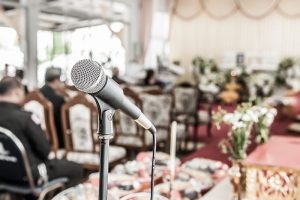Funeral Etiquette
A funeral is a custom many of us go through several times in our life, but it’s usually not often enough to gain the perfect amount of knowledge of funeral etiquette.
For funeral directors and workers at funeral homes, like The Gardens at Boca Raton – Cemetery and Chapel, have gone through hundreds of different memorial services. They know what’s appropriate and what’s not, and they share that knowledge with you here.
Good funeral etiquette is a must because the last thing any one of us wants to do is to draw attention away from the lost loved one or the grieving family during such a difficult time.
Keep these tips in mind for your next funeral so you can honor the death of someone you cared about, and show respect for their family and friends.
Knowing When to Arrive
Arriving after the funeral service has begun is very disrespectful to everyone involved – the grieving family, the loved one and those that arrived on time to watch the memorial service. Take possible traffic delays and parking difficulty into account when you plan your drive. Giving yourself a 10-minute cushion is a smart way to make sure you arrive on time, and it gives you a chance to talk with other respectful ones.
Also, one of the most important things you must do is turn your cell phone off before going into the funeral home. In stressful times, we might forget, so set a reminder in your phone 10 minutes ahead of time to turn it off.
Decoding Funeral Dress Codes
A funeral dress code is very subjective and will depend on things like cultural context, religious beliefs, and requirements, as well as the deceased’s personal style or preferences. You may choose to set a dress code for the funeral you are planning, and you’ll need to communicate those expectations to your guests.
Formal Dress Codes
Guests at a funeral with a formal dress code will wear conservative, dark colors. Men will often wear a black or dark grey suit with a light-colored shirt and dark tie, while women will typically wear a black or dark dress, suit, or a skirt that falls at or below the knees. Formal shoes are expected for both men and women.
Semi-Formal Dress Codes
A semi-formal funeral dress code will give some more flexibility for guests to choose their attire, but the expectation is still for subdued colors and respectful clothing. Men will still often wear a dark colored suit but may wear dress pants with either a blazer or sweater. A tie is optional for semi-formal. Women will still wear a dark-colored dress, skirt, or blouse, or may opt for dress pants with a blouse or sweater.
Casual Dress Code
Casual funeral dress codes will allow for lighter colors and less formal outfits. It’s still important to dress respectfully, though. Men can wear dress pants or khakis with a button-down or collared shirt, but jeans should be avoided unless the family specifically allows for them. Women can opt for a skirt or dress, a nice blouse, and slacks — but again, jeans should not be worn unless the family specifies for them.
Choosing Seasonally Appropriate Attire
Funeral clothing can get hot in the summer, so it’s best to choose linen, cotton, or another lighter, breathable fabric to keep cool — especially if some, or all, of the service will be held outdoors. In the fall, spring, and winter, wool is a good fabric choice in order to provide insulation. Wool will stand out in the summer as an odd choice, as will cotton or linen in the winter. Make sure that the fabric selection is seasonally appropriate.
Formal and semi-formal dress codes all offer ample opportunities for layering so you can stay warm in the winter. Things like overcoats, scarves, and thick socks can all insulate you from the cold while staying within the dress code.
Modesty Is Key
Regardless of dress codes, cultural expectations, or religious requirements, it’s important that funeral guests dress modestly and respectfully. A funeral is a time to honor the deceased and pay respects to the family in mourning, and attire should not take attention away from this process. If someone is dressed inappropriately or disrespectfully at a funeral, it may not be unreasonable to ask them to cover themselves or change clothing in order to respect all other attendees. Gaudy or flashy attire can be distracting and may upset other guests who have come with the expectation of a solemn ceremony to see their loved ones off.
Knowing Where to Sit
If you arrive early, you might think to fill the seats closest to the service, but usually the first row or two are saved for immediate family members. If you’re a distant relative, it might be better to wait until you are asked to move up and sit closer, than to just presume it. Again, remember that this is all about respecting the memory of a loved one. However, make sure you don’t sit so far back that there’s a large gap of empty seats between the family and friends. Sitting in the middle is the safest route.
Knowing How to Greet People
It’s appropriate to share your condolences with family members and close friends of the deceased, but it’s important to not make them feel like they have to carry on a long conversation with you. Say hello and that you are sorry for their loss, and then let them decide the rest of the conversation or if it has ended, then you can step back. The family might want to hear about what’s going on in your life at some point, but this is not that time. Keep your comments brief, and allow others at the service a chance to share their condolences with the family, as well.
Knowing How to Deal with Awkwardness
Often, some people won’t know what to say or how to act because funerals are just a socially awkward event for most people. It’s a sad occasion and it’s human nature to try to turn sadness into happiness – even though that’s not what funerals are about. So when someone says something insensitive or self-absorbed, be careful not to be offended and just give them the benefit of the doubt. They’re uncomfortable, so they’re dealing with it uncomfortably. Telling someone you’d rather not talk about it is completely acceptable.
There also might be customs and rituals you are not accustomed to during a funeral, which might cause some awkwardness. Being aware of them ahead of time might help you understand what’s happening, so feel free to do some research.
Knowing What to Send
Close friends and family members should call to see what you can do to help, while also offering your condolences. If you are not close to the family or the deceased, but still want to show your respects by sending something, talk with a family member’s spouse or someone else relatively close to see what you can do. Sending flowers is a well-meaning tradition, but many people ask that donations are made to charities instead. The funeral home will know whether the family would like flowers or anything else.
Sending a sympathetic message shows you care about the family, whether it’s by a greeting card or even a well-thought out email. This is probably better than calling them, since they can then choose when they’re ready to talk to people directly. Be genuine, but also be careful about what you say to someone that’s grieving. Avoid saying things like, you know how they feel, or that you’ve been through this before. Also, don’t say insensitive (but well-meaning) comments like the person is in a better place now, and that only the good die young. No one wants to hear that. Instead, concentrate on a message that tells them you are thinking about them and that you care.
Knowing How to Handle Young Ones
Bringing small children to a funeral is a tough decision because even well-behaved children might not understand the heft of the event. If you do have to bring them, explain to them what they should expect and why this even is important, and what you will expect out of them. If your children are too young or immature to know how to whisper and sit quietly for an extended period, you should probably not take them.
Adults that have lived through many funerals often know how to handle such an occasion, but young ones without much experience in these matters might not have the same understanding. Sharing this article with your young family members and friends is a smart way to help them understand how important good funeral etiquette can be.

